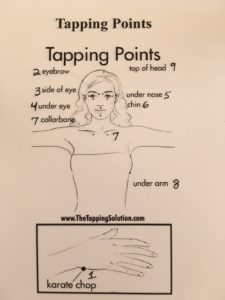Tapping acupressure points to assist emotional balancing, also sometimes referred to as Emotional Freedom Technique or EFT, is based on a combination of Chinese medicine (acupressure or meridian points), and Western psychotherapy. Meridian points are connected to the body’s energy flow. They are like the body’s freeway network for energy. Sometimes this freeway has emotional traffic jams. When this energy flow is disrupted, physical and emotional issues arise.
When stimulated, these acupressure points send signals to the stress centers of the brain. These signals bypass the thinking portion of the brain. The thinking portion of the brain is commonly only accessed during talk therapy. In this situation, the body’s emotional energy pathways are not shifted. This is the key component to why Tapping these acupressure points works. It is treating the causes, rather than just the symptoms.
Multiple studies have been done on the effects of EFT, some even by the prominent Harvard Medical School. The Medical School’s analysis described how stimulating the acupressure points reduced the brain’s stress and fear response. EFT balances the sympathetic and the parasympathetic nervous systems. One study by Dr. Dawson Church showed that average levels of Cortisol, the body’s stress hormone, were reduced by 24% in some 83 subjects, and up to 50% in others. Comparatively, those who underwent an hour of talk therapy showed no significant reduction in Cortisol.
This uses fingertip tapping to apply pressure on specific meridian or acupressure points sending signals to parts of the brain that control stress. The main area of the brain that is the center for fight or flight is called the amygdala. Many children with autism remain in the fight or flight response and have an over-active amygdala. Due to the extreme ongoing stressful lifestyle and worry, a parent of a child with autism will often remain in the same stress response.
Tapping has been used successfully with war veterans for PTSD, and is used for anxiety, insomnia, depression and even physical pain. A 2016 review, compared the effectiveness of using EFT tapping over standard care options for anxiety symptoms. The study concluded there was a significant decrease in anxiety scores compared to participants receiving other care. However, further research is needed to compare EFT treatment with other cognitive therapy techniques.
How To Use Tapping Points
Tapping is simple and painless. Anyone can learn to do it. While tapping with your fingertips on specific meridian points, you are to think of an emotional incident in your life that may be the trigger for current feelings and actions like anxiety, distraction, insomnia, relationships, financial pressure, pain, depression, and most disease. Measure this feeling now on a scale from one to ten, ten being the worst.
Think of either the first or the worst incident you can remember. While thinking about, this talk through how you are feeling now. If you cannot think of a specific memory, then just talk about how you feel when certain things happen to you that cause you to feel those emotions. Assess the level again from one to ten, with ten being the worst, on how intense the feelings are.
While talking about the issues, concentrate on resolving the negative emotion.This shifts your body’s energy and restores balance. Begin tapping with your fingertips on the points shown below. Go through several rounds of it until you notice the negative feelings subsiding. When you are finished, measure the emotions from one to ten again. You will likely feel a difference already.
If you are doing this for children who are unable to express themselves, you can teach them to tap on the points or do it for them. They do not even have to tap in the specific order listed, or on all of them. It will still work. By tapping on any of the points listed below, the energy will shift in the body and often bring calmness.
Where To Tap The Points

Tap about nine times each of the nine points in the following sequence:
Side of hand: Tap the outside edge of your hand (karate chop side)
Eyebrow (EB): Tap the inner edges of the eyebrows, closest to the bridge of the nose with two fingers.
Side of eye (SE): Tap the hard area between the eye and the temple with two fingers. Feel out this area gently so you don’t poke yourself in the eye!
Under eye (UE): Tap the hard area under the eye that merges with the cheekbone with two fingers in a line beneath the pupil.
Under nose (UN): Tap the point centered between the bottom of the nose and the upper lip with two fingers.
Chin (CP): This point is right beneath the previous one, and is centered between the bottom of the lower lip and the chin.
Collarbone (CB): Tap just below the hard ridge of your collarbone with four fingers.
Underarm (UA): Tap your side, about four inches beneath the armpit with four fingers.
Head (TH): Tap the crown, center, and top of the head with all four fingers on both hands.You’ve completed the sequence.
As you tap on each point, repeat a simple reminder phrase, such as “my anxiety” or “my child” or “my financial situation.”
Now take another deep breath!
Afterward, remember to focus and measure your level of intensity compared to the level it was at before you did the Tapping. Continue the sequence multiple times until you feel it has either significantly reduced or is gone.
This is very easy to do on your own and does not require a practitioner but some people like to get assistance. If you would like to talk to an educated practitioner or schedule a session with one then there is a resource available. You can find an educated EFT practitioner here.
Please also read and listen to my additional podcast episodes on emotional clearing:
Clearing Trapped Emotions with the Emotion Code [Podcast Episode 9]
EMDR Eye Movement Therapy for Overcoming Anxiety, Stress and Trauma [Podcast Episode 85]











